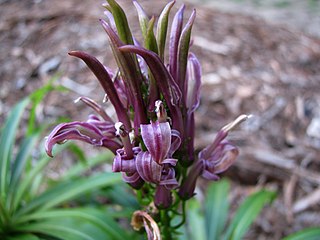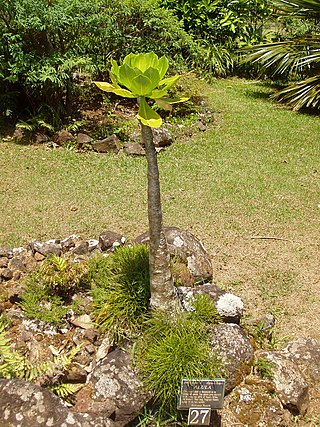
Haleakalā, or the East Maui Volcano, is a massive, active shield volcano that forms more than 75% of the Hawaiian Island of Maui. The western 25% of the island is formed by another volcano, Mauna Kahalawai, also referred to as the West Maui Mountains.

Haleakalā National Park is an American national park located on the island of Maui in the state of Hawaii. Named after Haleakalā, a dormant volcano within its boundaries, the park covers an area of 33,265 acres, of which 24,719 acres is a wilderness area. The land was designated a national park in 1976 and its boundaries expanded in 2005.

The family Campanulaceae, of the order Asterales, contains nearly 2400 species in 84 genera of herbaceous plants, shrubs, and rarely small trees, often with milky sap. Among them are several familiar garden plants belonging to the genera Campanula (bellflower), Lobelia, and Platycodon (balloonflower). Campanula rapunculus and Codonopsis lanceolata are eaten as vegetables. Lobelia inflata, L. siphilitica and L. tupa and others have been used as medicinal plants. Campanula rapunculoides may be a troublesome weed, particularly in gardens, while Legousia spp. may occur in arable fields.

Argyroxiphium is a small genus of plants in the family Asteraceae. Its members are known by the common names silversword or greensword due to their long, narrow leaves and the silvery hairs on some species. The silverswords belong to a larger radiation of over 50 species, including the physically different genera Dubautia and Wilkesia. This grouping is often referred to as the silversword alliance. Botanist P. H. Raven referred to this radiation as "the best example of adaptive radiation in plants".

Pritchardia remota, the Nihoa pritchardia, Nihoa fan palm, or Loulu, is a species of palm endemic on the island of Nihoa, Hawaiʻi, and later transplanted to the island of Laysan. It is a smaller tree than most other species of Pritchardia, typically reaching only 4–5 metres (13–16 ft) tall and with a trunk diameter of 15 centimetres (5.9 in). It is the only type of tree on the island and used to be abundant. In 1885 a wildfire ravaged the island, destroying most of the palms. Only about 700 of these trees remain, making the species endangered but numbers are slowly increasing. The palm is being cultivated in botanical gardens.

The Hawaiian lobelioids are a group of flowering plants in the bellflower family, Campanulaceae, subfamily Lobelioideae, all of which are endemic to the Hawaiian Islands. This is the largest plant radiation in the Hawaiian Islands, and indeed the largest on any island archipelago, with over 125 species. The six genera involved can be broadly separated based on growth habit: Clermontia are typically branched shrubs or small trees, up to 7 metres (23 ft) tall, with fleshy fruits; Cyanea and Delissea are typically unbranched or branching only at the base, with a cluster of relatively broad leaves at the apex and fleshy fruits; Lobelia and Trematolobelia have long thin leaves down a single, non-woody stem and capsular fruits with wind-dispersed seeds; and the peculiar Brighamia have a short, thick stem with a dense cluster of broad leaves, elongate white flowers, and capsular fruits. The relationships among the genera and sections remains unsettled as of April 2022.

Brighamia insignis, commonly known as ʻŌlulu or Alula in Hawaiian, or colloquially as the vulcan palm or cabbage on a stick, is a endangered species of Hawaiian lobelioid in the bellflower family, Campanulaceae. It is native to the islands of Kauaʻi and Niʻihau. This short-lived perennial species is a member of a unique endemic Hawaiian genus with only one other species.
Hibiscadelphus woodii, or Wood's hau kuahiwi, is a species of flowering plant in the family Malvaceae endemic to Kauai, Hawaii.

Cyanea is a genus of flowering plants in the family Campanulaceae that are endemic to Hawaii. The name Cyanea in Hawaiian is hāhā.
Cyanea dolichopoda was a species of shrub in the bellflower family that was endemic to Kauai. It was discovered in 1990 and has not been located in the wild since 1992. Like other Cyanea it is known as haha in Hawaiian.
Cyanea eleeleensis was a rare species of flowering plant in the bellflower family known by the common name Eleele cyanea. It was endemic to Kauai, where it has been declared extinct. It was federally listed as a critically endangered species of the United States in 2010. Like other Cyanea it is known as haha in Hawaiian.
Cyanea kuhihewa is a rare species of flowering plant in the bellflower family known by the common name Limahuli Valley cyanea. It is endemic to Kauai, where only two mature plants are known from a single wild population. Like other Cyanea it is known as haha in Hawaiian.

Cyanea remyi is a rare species of flowering plant in the bellflower family known by the common name Remy's cyanea. It is endemic to Hawaii, where it is known only from the island of Kauai. It is a federally listed endangered species of the United States. Like other Cyanea, it is known as haha in Hawaiian.

Delissea rhytidosperma, is known by the common names Kauai delissea, Kauai leechleaf delissea, and leechleaf delissea. It is a rare species of flowering plant in the bellflower family, that is endemic to Hawaii where it is known only from the island of Kauai. It is critically endangered or extinct in the wild.
Cyanea rivularis is a rare species of flowering plant in the bellflower family known by the common name plateau cyanea. It is endemic to Hawaii, where it is known only from the island of Kauaʻi. There are three small populations of the plant remaining in the wild, for a total of 19 individual plants. The plant was federally listed as an endangered species of the United States in 1996.

Delissea subcordata is a rare species of flowering plant in the bellflower family known by the common names Koʻolau Range delissea and oha. It is endemic to Hawaii, where it is known only from the island of Oahu. It is now only found in the Waianae Mountains, and it is believed to be extirpated from the Koʻolau Range, where it once occurred. As of 2008 there were 40 individuals remaining, 28 of which were mature plants. This plant was federally listed as an endangered species of the United States in 1996.

Isodendrion pyrifolium is a rare species of flowering plant in the violet family known by the common name wahine noho kula. It is endemic to Hawaii, where it is known only from the island of Hawaii. It is a federally listed endangered species of the United States.

Delissea kauaiensis is a critically endangered species of the bellflower family. It is found on Mt. Ha'upu near Hanapepe Falls, and Mahanaloa. It was thought to be extinct, but 10 individuals were found in 2016. It is known as ‘Oha in Hawaiian, and has the English common names of Kauaʻi delissea, KauaʻI leechleaf delissea, and Leechleaf delissea.

Cyanea asplenifolia is a flowering plant in the Campanulaceae family. The IUCN has classified the species as critically endangered. It is native to the Hawaiian Islands.
Cyanea calycina is a flowering plant in the Campanulaceae family. The IUCN has classified the species as critically endangered. It is native to the Hawaiian Islands. An example is being monitored with a plant cam.













